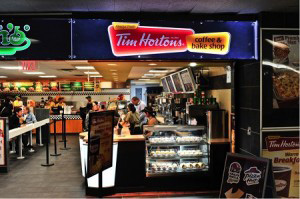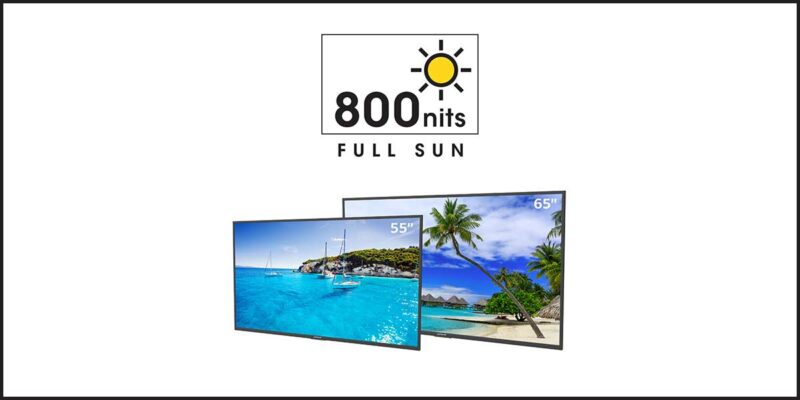InfoComm: Why Digital Signage Will Be More Prominent in Quick-Service Restaurants
By Brian McClimans
Vice President of Global Business Development, Peerless-AV
 Digital signage isn’t the next big thing to hit the quick-service restaurant (QSR) industry — it’s already here. There are several fast-casual restaurants that are already using digital menu boards, including Tim Hortons. They’ve implemented this technology in many locations and they’re looking to achieve system-wide digital integration by the summer.
Digital signage isn’t the next big thing to hit the quick-service restaurant (QSR) industry — it’s already here. There are several fast-casual restaurants that are already using digital menu boards, including Tim Hortons. They’ve implemented this technology in many locations and they’re looking to achieve system-wide digital integration by the summer.
Take a look at the photo from a Tim Hortons restaurant in New York City. It’s easy to notice the difference between the Tim Hortons digital menu boards and the static menu boards from the Nathan’s counter beside it. When one QSR goes digital, it’s likely that competitors will go digital, too, once the technology proves firsthand to provide a better customer experience.
Last year, Burger King was the first to fully implement digital menu boards inside their restaurants, while Dunkin’ Donuts and Dairy Queen have started to slowly adopt the technology. McDonald’s has used digital pre-sell menu boards inside their restaurants to highlight its McCafé premium coffee product, resulting in a dramatic increase in coffee sales.
Going digital has been a bit of a slower process for most QSRs, mainly due to the initial cost of acquiring the equipment. More often than not, it’s up to individual franchisees to elect to invest in the digital menu board equipment. When shown the potential profit increases that digital menu boards can bring to a QSR, it becomes more apparent that the technology is, indeed, well worth the investment.
Some have also been waiting to see the benefit of going digital aside from just being able to change prices easily or switch between menus for breakfast, lunch, and dinner. Overall, it’s a way for the QSR staff to provide a better experience for every customer, especially when there are only a few short moments to grab and retain the customer’s attention.
Owners of airports and malls have made digital signage a requirement to lessees so they can stay ahead of the curve and maintain a fresh look. All they need is an Internet connection and the right software, content player, digital signage displays and mounts.
Using and Understanding the Right Technology
There are many QSRs that don’t totally understand digital menu boards when implementing them. If they don’t employ the correct software or content player, they may run into problems. There’s nothing worse than a restaurant menu that is asking if you would like to install a Windows update.
To prevent this, QSR franchisees and owners need to do the research into the technology and buy the right product for the application. Anyone can literally take a computer and create the digital menu board content, but error messages and pop-ups will appear right over the menu if the wrong type of content media player is running.
One important factor is the location of the computer(s) that control the menu board content. The best place to put the computer is either directly behind the displays or wired in a room that’s away from the chaos of the kitchen. Keeping the computer away from grease will help keep maintenance and system outages to a minimum.
It’s also logical that digital menu boards must be mounted properly. There’s not one standard for every QSR, since each store was built at a different time and most likely used differing technologies. The Rock n’ Roll McDonald’s in Chicago always catches my eye whenever I go to the city. Implementing digital menu boards there would be different than installing them in any neighborhood McDonald’s here in Aurora, Ill., since the aesthetics of both locations are unique. There’s no one-size-fits-all format for QSRs, so do your research into the signage and mounts that will work best for your location.
What’s Next for QSRs
A majority of QSRs will have digital signage implemented in the next two or three years. It will be integrated first in the drive-thrus and then throughout the inside. Statistics from QSR Magazine state that anywhere between 50 and 70 percent of sales come from the drive-thru, meaning that franchise owners are more likely to invest more money there. Of course, QSRs will want to update where they are most profitable. More bang for the buck.
I also see drive-thrus using Bluetooth at some point in the future, for even faster turnaround. BK announced in March that they were launching a mobile app that allows customers to place an order when they are waiting in the drive-thru line. By the time they reach the service window, their order will be ready. Shortly after BK’s announcement, Wendy’s introduced mobile payments to their current iOS app.
All signs are pointing towards digital for the QSR industry. Have you seen digital signage in QSRs? Let me know which QSRs are implementing it in your area by commenting below!
This blog was reprinted with permission from InfoComm International and originally appeared here.





